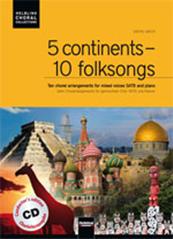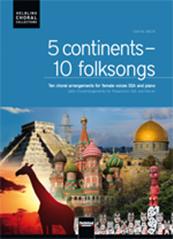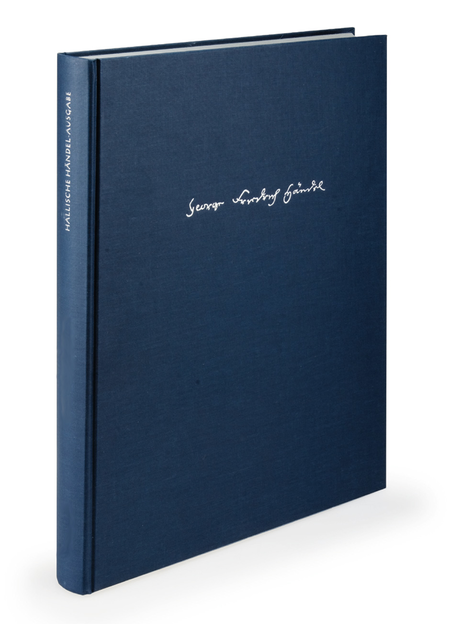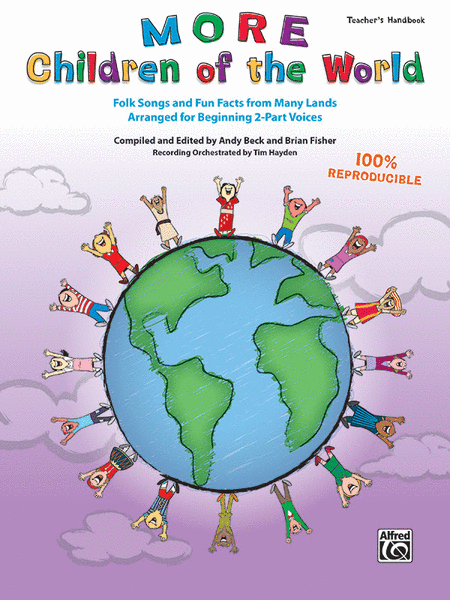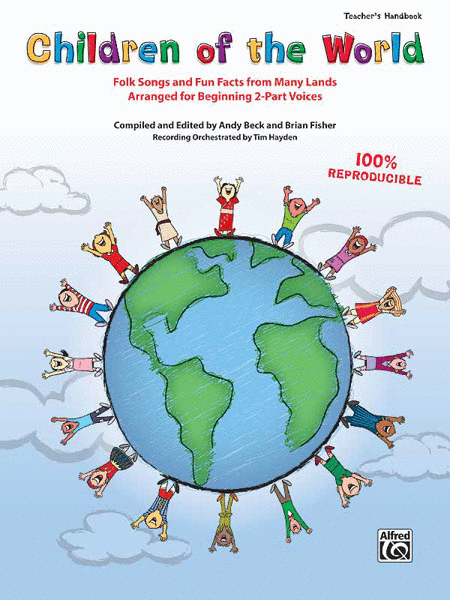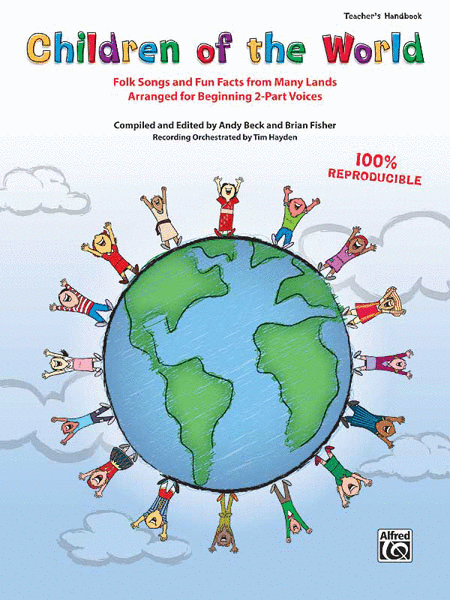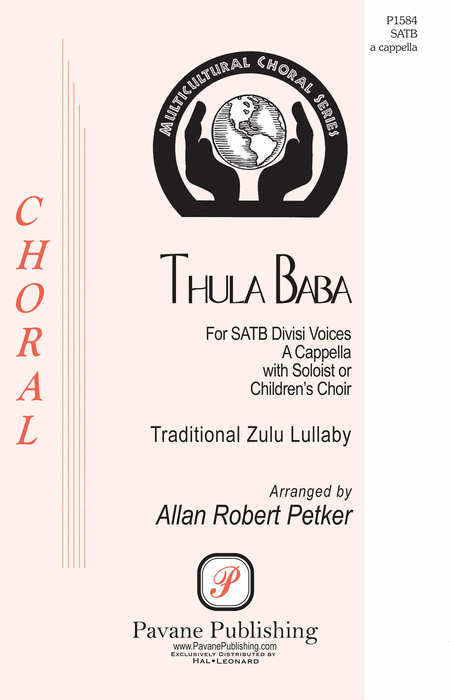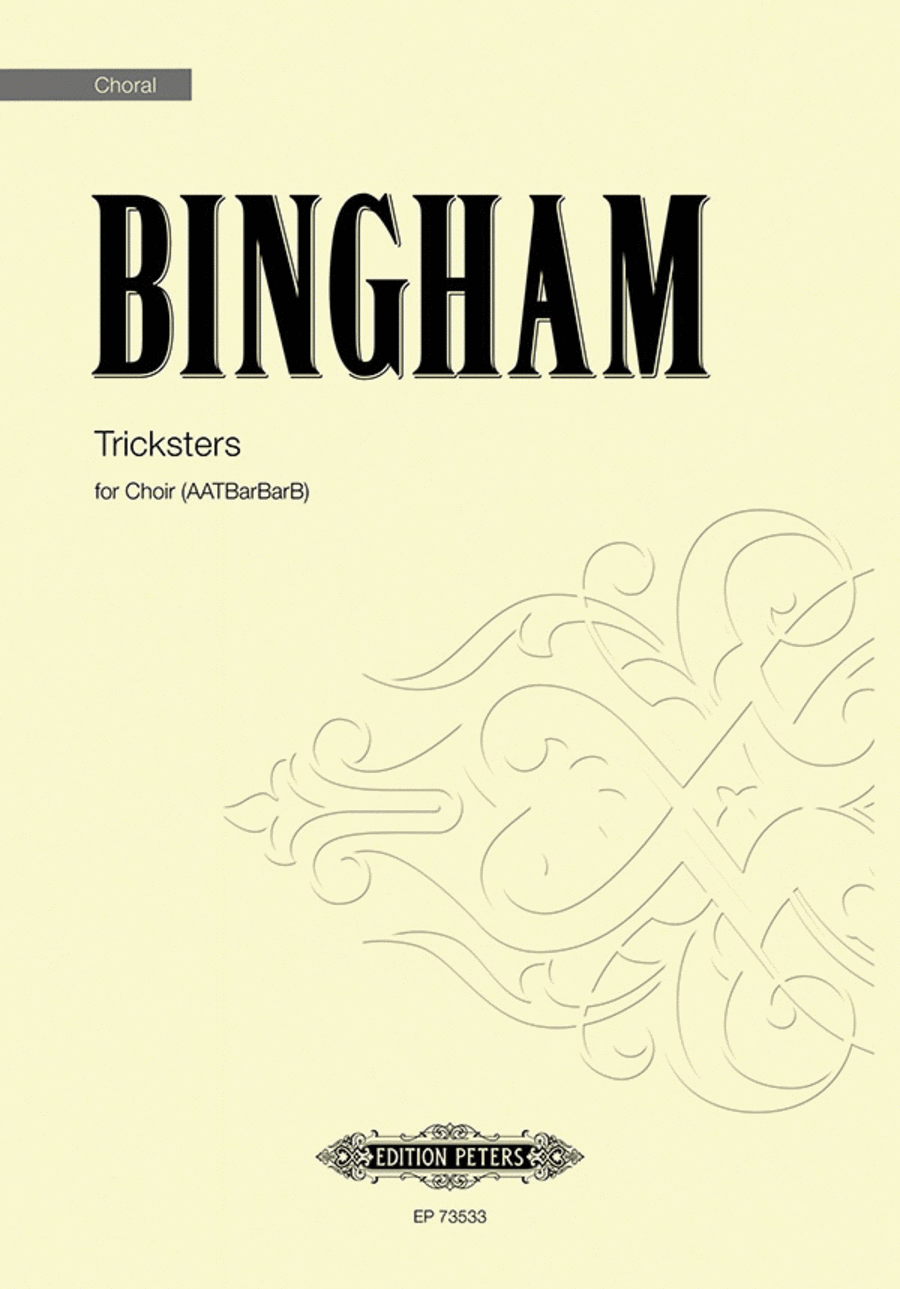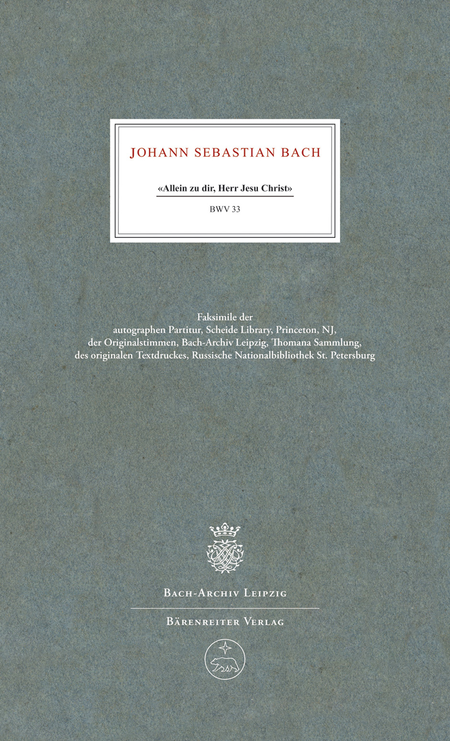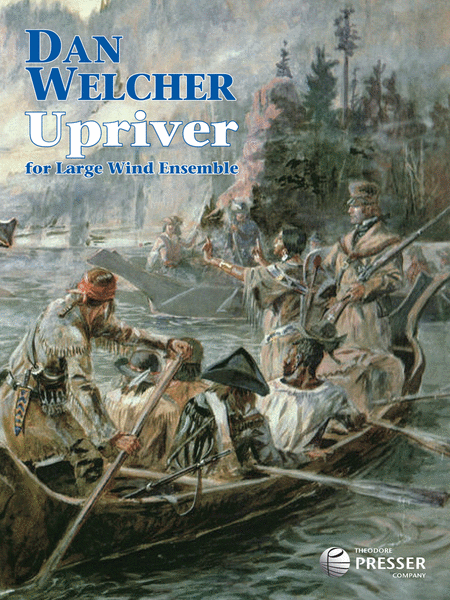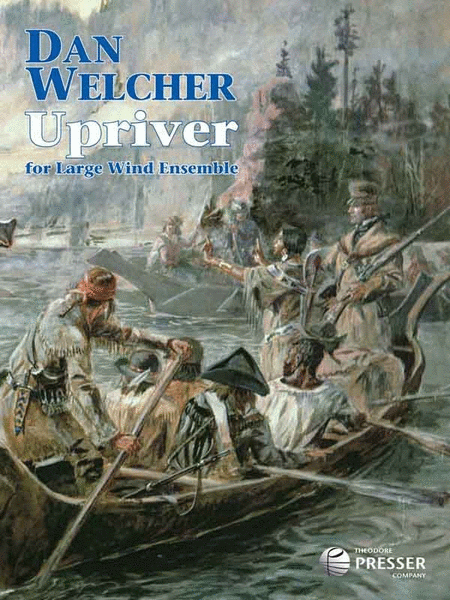|
| 5 Continents Choral
Edition
Chorale SATB
SATB, Piano
Helbling Verlagsgesellschaft m.b.h
5 Continents. Cette collection par Gwyn Arch de dix chansons folkloriques peut-�...(+)
5 Continents. Cette collection par Gwyn Arch de dix chansons folkloriques peut-être petit, mais cinq continents sont représentés au sein de ces 76 pages, et chaque continent.Du Mexique (Amérique du Sud) vient de La Cucaracha (le cafard), une chanson populaire en langue espagnole avec une mélodie mémorable et Cielito Lindo qui est tré par les Mexicains comme une sorte d'hymne national alternative. Le continent africain est représenté par une chanson à partir de la Tanzanie, Malaika, et une autre Afrique de l'Ouest se réjouir dans le titre Jikela Emaweni hamba sia. Les deux chansons ont été associés à la célèbre chanteuse sud-africaine et militant des droits civiques Miriam Makeba, et de nouvelles paroles (en anglais) ont été fournis par Stuart Smith. En Russie (Europe) musique folklorique est étroitement liée à la vie du village et ses traditions. Kalinka est la rêverie d'un jeune homme sous un pin, tandis que le bouleau Little était un symbole de la beauté en Russie soviétique. Le quatrième continent est l'Asie. S'il ya une chanson juive connue par les Juifs et non-Juifs, il doit être Hava Nagilah. Tum Balalaika est également un traditionnel yiddish, mais il est d'origine juive russe. Le Folkmusic des Maoris de Nouvelle-Zélande (Océanie) est principalement associée à la guerre chants appelé Haka, mais Hine e Hine et Pokarekare Ana révèlent l'influence des colons milieu du 19e siècle britanniques. / Choeur Mixte (SATB) Et Piano
Délais: 2-5 jours - En Stock Fournisseur | | |
| 5 Continents - Choral
Edition
Chorale SATB
SATB, Piano [Partition + CD]
Helbling Verlagsgesellschaft m.b.h
5 Continents. Cette collection par Gwyn Arch de dix chansons folkloriques peut-�...(+)
5 Continents. Cette collection par Gwyn Arch de dix chansons folkloriques peut-être petit, mais cinq continents sont représentés au sein de ces 76 pages, et chaque continent.Du Mexique (Amérique du Sud) vient de La Cucaracha (le cafard), une chanson populaire en langue espagnole avec une mélodie mémorable et Cielito Lindo qui est tré par les Mexicains comme une sorte d'hymne national alternative. Le continent africain est représenté par une chanson à partir de la Tanzanie, Malaika, et une autre Afrique de l'Ouest se réjouir dans le titre Jikela Emaweni hamba sia. Les deux chansons ont été associés à la célèbre chanteuse sud-africaine et militant des droits civiques Miriam Makeba, et de nouvelles paroles (en anglais) ont été fournis par Stuart Smith. En Russie (Europe) musique folklorique est étroitement liée à la vie du village et ses traditions. Kalinka est la rêverie d'un jeune homme sous un pin, tandis que le bouleau Little était un symbole de la beauté en Russie soviétique. Le quatrième continent est l'Asie. S'il ya une chanson juive connue par les Juifs et non-Juifs, il doit être Hava Nagilah. Tum Balalaika est également un traditionnel yiddish, mais il est d'origine juive russe. Le Folkmusic des Maoris de Nouvelle-Zélande (Océanie) est principalement associée à la guerre chants appelé Haka, mais Hine e Hine et Pokarekare Ana révèlent l'influence des colons milieu du 19e siècle britanniques. / Choeur Mixte (SATB) Et Piano
Délais: 2-5 jours - En Stock Fournisseur | | |
| 5 Continents Choral
Edition
Voix haute, Piano
Helbling Verlagsgesellschaft m.b.h
5 Continents. Cette collection par Gwyn Arch de dix chansons folkloriques peut-�...(+)
5 Continents. Cette collection par Gwyn Arch de dix chansons folkloriques peut-être petit, mais cinq continents sont représentés au sein de ces 76 pages, et chaque continent.Du Mexique (Amérique du Sud) vient de La Cucaracha (le cafard), une chanson populaire en langue espagnole avec une mélodie mémorable et Cielito Lindo qui est tré par les Mexicains comme une sorte d'hymne national alternative. Le continent africain est représenté par une chanson à partir de la Tanzanie, Malaika, et une autre Afrique de l'Ouest se réjouir dans le titre Jikela Emaweni hamba sia. Les deux chansons ont été associés à la célèbre chanteuse sud-africaine et militant des droits civiques Miriam Makeba, et de nouvelles paroles (en anglais) ont été fournis par Stuart Smith. En Russie (Europe) musique folklorique est étroitement liée à la vie du village et ses traditions. Kalinka est la rêverie d'un jeune homme sous un pin, tandis que le bouleau Little était un symbole de la beauté en Russie soviétique. Le quatrième continent est l'Asie. S'il ya une chanson juive connue par les Juifs et non-Juifs, il doit être Hava Nagilah. Tum Balalaika est également un traditionnel yiddish, mais il est d'origine juive russe. Le Folkmusic des Maoris de Nouvelle-Zélande (Océanie) est principalement associée à la guerre chants appelé Haka, mais Hine e Hine et Pokarekare Ana révèlent l'influence des colons milieu du 19e siècle britanniques. / Voix Elevée(s) Et Piano
Délais: 2-5 jours - En Stock Fournisseur | | |
| Memories Of Choirs And
Cloisters (BREWER HERBERT
A)
Chorale [Partition]
Stainer and Bell
Par BREWER HERBERT A.. Organist of Gloucester Cathedral from 1896 till his death...(+)
Par BREWER HERBERT A.. Organist of Gloucester Cathedral from 1896 till his death in 1928, as well as composer, choir-trainer, adjudicator and teacher, Sir Herbert Brewer was involved for over three decades with the Three Choirs Festival, and his Memories of Choirs and Cloisters offers a vivid account of the planning and execution of the festivals in that time, those at Gloucester in particular.
Though his professional life was spent exclusively in the provinces, his championing of contemporary music brought him into wide contact with composers and other artistic figures both from Britain and the continent, including Robert Bridges, Elgar, Glazunov, Rider Haggard, Parry, Quiller-Couch, Ravel, Saint-Saëns and Sibelius (whose Luonnotar he premiered). John Morehen's fine new edition places Brewer's lively and insightful recollections of these and other encounters and connections in context for the modern reader, making the book an important addition to our fuller understanding of a remarkable period in British music.
Neither a conventional autobiography nor a diary, but a collection of reminiscences compiled towards the end of his life, Brewer's Memories reveals a scrupulous and astute musician of great integrity, warm-hearted with a devotion to social justice and civic duty, and with a mischievous sense of humour./ Recueil / Choeur
Délais: 2-5 jours - En Stock Fournisseur | |
|
|
|
| Almira, Konigin von Kastilien HWV 1
Chorale SATB
Barenreiter
Solo voices, choir, orchestra (3 Soprano Voice Solo, 3 Tenor Voice Solo, 2 Bass ...(+)
Solo voices, choir,
orchestra (3 Soprano
Voice Solo, 3 Tenor Voice
Solo, 2 Bass Voice Solo,
SATB Choir, 2
recorder-Alto, 2 Oboe,
bassoon, 3 Trumpets,
timpani, 3 Violins,
Viola, Cello, Bassi(Vc,
double bass, bassoon,
harpisc.)) SKU:
BA.BA04050 Opera
in three acts.
Composed by George
Frideric Handel. Edited
by Dorothea Schröder.
This edition: complete
edition, urtext edition.
Linen. Halle Handel
Edition (HHA) Series II,
Volume 1. Oper, Barock
(Opera, Baroque).
Complete edition, Score.
HWV 1. Duration 3 hours,
30 minutes. Baerenreiter
Verlag #BA04050_00.
Published by Baerenreiter
Verlag (BA.BA04050).
ISBN 9790006443598. 33
x 26 cm inches. Language:
German. Text: Feustking,
Friedrich
Christian. “A
lmiraâ€,
Handel’s first
opera, was well received
when premiered in 1705 at
the Theater am
Gänsemarkt in Hamburg.
The director was Reinhard
Keiser, who, remarkably,
had himself already set
Friedrich Christian
Feustking’s text
to music. The role of
Fernando was sung by
Johann Mattheson. The
translation used by
Handel leaves several
Italian arias in their
original language,
resulting in a delightful
mixture of German and
Italian.
The opera
which, after sundry
entangled romances, ends
in the wedding of three
couples, is characterised
by exuberant scenes: the
procession at
Almira’s crowning
ceremony, a duel, a
prison scene and a
masked-ball involving the
three continents Europe,
Africa and Asia.
The vocal score
to “Almiraâ€
by George Frideric Handel
brings about a small
sensation: Whilst
conducting a reenactment
of this work in 1732,
Georg Philipp Telemann
removed the Aria no. 28
“Ingrato,
spietato†from his
conducting score. Since
then this aria has been
deemed lost. Due to
necessity only the edited
vocal text devoid of any
music was presented in
the 1994 volume of the
“Halle Handel
Editionâ€.
Thanks to a recently
discovered contemporary
manuscript copy from the
beginning of the 18th
century which was found
in the music library of
the Mariengymnasium in
Jever, this aria has now
been made available to
performers for the first
time in this new vocal
score edition. Previous
to this the corresponding
pages could only be seen
as a facsimile in an
article of the
“Göttinger
Händel-Beiträgeâ�
�.
Now the aria can
be performed again.
Furthermore, with the
help of this new source,
missing measures in the
basso continuo which had
initially been completed
by the editor of the
“Halle Handel
Edition†volume,
could be reconstructed
from the basso continuo
part of the Bellante aria
“Ich brenne
zwar†(no. 71).
About
Barenreiter
Urtext
What can I
expect from a Barenreiter
Urtext
edition?<
/p> MUSICOLOGICA
LLY SOUND
- A
reliable musical text
based on all available
sources
- A
description of the
sources
-
Information on the
genesis and history of
the work
- Valuable
notes on performance
practice
- Includes
an introduction with
critical commentary
explaining source
discrepancies and
editorial decisions
... AND
PRACTICAL
-
Page-turns, fold-out
pages, and cues where you
need them
- A
well-presented layout and
a user-friendly
format
- Excellent
print quality
-
Superior paper and
binding

$380.95 - Voir plus => AcheterDélais: 1 to 2 weeks | | | |
| More Children of the World
Chorale 2 parties
Alfred Publishing
Folk Songs and Fun Facts from Many Lands Arranged for Beginning 2-Part Voices...(+)
Folk Songs and Fun
Facts from Many Lands
Arranged for Beginning
2-Part Voices (Teacher's
Handbook). Composed
by Compiled; edited by
Andy Beck; Brian Fisher;
recording orch. Tim
Hayden. This edition:
Teacher's Handbook (100%
Reproducible).
Classroom/Pre-School;
Musicals; Musicals and
Programs; Reproducible.
Folk; Multicultural;
Secular. Book. 80 pages.
Alfred Music #00-45645.
Published by Alfred Music
(AP.45645).
$34.99 - Voir plus => AcheterDélais: 1 to 2 weeks | | | |
| Children of the World
Chorale 2 parties
2 parties, Piano [Edition pour professeur]
Alfred Publishing
(Folk Songs and Fun Facts from Many Lands, Arranged for Beginning 2-Part Voices)...(+)
(Folk Songs and Fun Facts
from Many Lands, Arranged
for Beginning 2-Part
Voices). Edited by Andy
Beck and Brian Fisher.
2-Part Choir. This
edition: Teacher's
Handbook (100%
Reproducible).
Classroom/Pre-School;
General Music and
Classroom Publications;
Reproducible.
Multicultural; World.
Book. 84 pages
$34.99 - Voir plus => AcheterDélais: 1 to 2 weeks | | | |
| Children of the World
Chorale 2 parties
2 parties [Partition + CD]
Alfred Publishing
(Folk Songs and Fun Facts from Many Lands, Arranged for Beginning 2-Part Voices)...(+)
(Folk Songs and Fun Facts
from Many Lands, Arranged
for Beginning 2-Part
Voices). Edited by Andy
Beck and Brian Fisher.
This edition: CD Kit.
Classroom/Pre-School;
General Music and
Classroom Publications;
Reproducible.
Multicultural; World.
Book and CD. 84 pages.
Published by Alfred Music
Publishing
$69.99 - Voir plus => AcheterDélais: 1 to 2 weeks | | | |
| Thula Baba
Chorale SATB
Pavane Publishing
Composed by Jan Seidel. Arranged by Allan Robert Petker. This edition: Saddle ...(+)
Composed by Jan Seidel.
Arranged by Allan Robert
Petker. This edition:
Saddle
stitching. Sheet music.
Pavane Choral. Festival,
Concert, World Music.
Octavo.
Composed 1973. 1584. 12
pages. Pavane Publishing
#P1584. Published by
Pavane
Publishing
$2.45 - Voir plus => AcheterDélais: 24 hours - In Stock | | | |
| I Sing, You Sing -- Learning Songs - SoundTrax CD (CD only)
CD Chorale
Alfred Publishing
SKU: AP.41853 30 Echo Songs for Young Singers (SoundTrax). Compose...(+)
SKU: AP.41853
30 Echo Songs for
Young Singers
(SoundTrax). Composed
by Jay Althouse, Sally K.
Albrecht, and recording
orch. Tim Hayden. This
edition: SoundTrax CD.
Classroom/Pre-School;
Echo Songs; General Music
and Classroom
Publications - Songbooks;
Songbooks. I Sing, You
Sing. Accompaniment and
performance CD. Alfred
Music #00-41853.
Published by Alfred Music
(AP.41853). UPC:
038081469331. English.
Recording orch. Tim
Hayden. An exciting
addition to Alfred
Music's I Sing, You Sing
echo song series. These
30 call and response
songs encompass a wide
variety of subjects,
including: important
everyday lessons (like
crossing the street and
answering the telephone),
music class fundamentals
(like the instruments of
the orchestra and major
vs. minor), and
cross-curricular
reinforcements (like
identifying the
continents and
multiplying by two).
Singers may echo the
leader provided on the
SoundTrax CD or take
turns being leaders
themselves---two versions
of each song are included
on the recording.
Recommended for grades
K--4. Chord symbols and
suggested classroom
activities are
provided. $34.99 - Voir plus => AcheterDélais: 1 to 2 weeks | | | |
| Tricksters
Peters
Choir Secular (AATB choirarBarB) SKU: PE.EP73533 For Choir (AATBarBarB...(+)
Choir Secular (AATB
choirarBarB) SKU:
PE.EP73533 For
Choir (AATBarBarB).
Composed by Judith
Bingham. Choral Octavo.
Contemporary; Secular.
Choral Octavo. 32 pages.
Edition Peters
#98-EP73533. Published by
Edition Peters
(PE.EP73533). ISBN
9790577021027. Tric
ksters by Judith Bingham
is a contemporary choral
work for AATBarBarB about
the trickster gods of
ancient cultures. In this
fantasy piece several
tricksters from different
continents try to
persuade the Earth Maker
that they have the secret
of fire. Tricksters was
commissioned and first
performed by the King
Singers on 08 October
2020 at The Cathedral of
Saint Mother Theresa,
Pristina, Kosovo, as part
of the Second Pristina
International Vocal
Festival. $16.95 - Voir plus => AcheterDélais: 1 to 2 weeks | | | |
| Allein zu dir, Herr Jesu Christ, BWV 33
Barenreiter
SKU: BA.BVK02201 Cantata for the 13th Sunday after Trinity (composed f...(+)
SKU: BA.BVK02201
Cantata for the 13th
Sunday after Trinity
(composed for September
3, 1724). Autograph
Score: Scheide Library,
Princeton, NJ. Original
Parts: Bach-Archiv
Leipzig,
Thomana-Sammlung. Text
Booklet (1724): Russische
Nationalbibliothek.
Composed by Johann
Sebastian Bach. Edited by
Bach-Archiv Leipzig,
Christoph Wolff, and
Peter Wollny. This
edition: facsimile. In a
slipcase. Facsimile. BWV
33. 20/46/13/15 pages.
Baerenreiter Verlag
#BVK02201_00. Published
by Baerenreiter Verlag
(BA.BVK02201). ISBN
9783761822012. 38 x 24 cm
inches. Text Language:
German,
English. The
cantataAllein zu dir,
Herr Jesu ChristBWV 33,
composed for the
Thirteenth Sunday after
Trinity in 1724, is now
the only vocal work by
Bach for which the
complete source material
from the time of
composition can be
published in facsimile.
It is one of the few
works by Bach for which
material from the first
performance survives
almost complete. But this
is held in different
locations on several
continents: the
composition score is
preserved in the Scheide
Library at Princeton , US
, the performance parts
in the Bach- Archiv
Leipzig and the libretto
of 1724 in the Russian
National Library in St.
Petersburg . All these
components have now been
published in a
high-quality facsimile
edition.
This
valuable edition, with a
slip case, offers both
specialists and lovers of
Bach's music a unique
insight into the
composer's working
methods and the changing
performing circumstances
he encountered.
Additional information is
contained in a detailed
commentary (in German and
English) by Christoph
Wolff and Peter Wollny
.
BWV 33 belongs
to the unique annual
cycle of chorale cantatas
composed by Bach in
1724/25, the second year
of his Leipzig tenure.
The cantata is one of the
very few works where all
the relevant source
materials for the first
performance have been
preserved but are kept in
various libraries
throughout the world :
The composing score is
kept at the Scheide
Library in Princeton, the
vocal-instrumental
performing parts at the
Bach Archive Leipzig and
the original libretto at
the Russian National
Library in St.
Petersburg.
The
facsimile offers
invaluable insights into
the composer's workings
and the changing
conditions for
performances under his
direction.
- Published to commorate
the 325 th anniversary of
Bach's birth on 21 March
2010
- Limited
edition of 100 copies
- Net proceeds go to the
Bach Archive,
Leipzig
$520.95 - Voir plus => AcheterDélais: 1 to 2 weeks | | | |
| Upriver
Orchestre d'harmonie [Conducteur]
Theodore Presser Co.
Band Concert Band SKU: PR.465000130 For Large Wind Ensemble. Compo...(+)
Band Concert Band SKU:
PR.465000130 For
Large Wind Ensemble.
Composed by Dan Welcher.
Sws. Contemporary. Full
score. With Standard
notation. Composed 2010.
Duration 14 minutes.
Theodore Presser Company
#465-00013. Published by
Theodore Presser Company
(PR.465000130). ISBN
9781598064070. UPC:
680160600144. 9x12
inches. Following a
celebrated series of wind
ensemble tone poems about
national parks in the
American West, Dan
Welcher’s Upriver
celebrates the Lewis &
Clark Expedition from the
Missouri River to
Oregon’s Columbia
Gorge, following the
Louisiana Purchase of
1803. Welcher’s
imaginative textures and
inventiveness are freshly
modern, evoking our
American heritage,
including references to
Shenandoah and other folk
songs known to have been
sung on the expedition.
For advanced players.
Duration:
14’.
In 1803,
President Thomas
Jefferson sent Meriwether
Lewis and William
Clark’s Corps of
Discovery to find a water
route to the Pacific and
explore the uncharted
West. He believed woolly
mammoths, erupting
volcanoes, and mountains
of pure salt awaited
them. What they found was
no less mind-boggling:
some 300 species unknown
to science, nearly 50
Indian tribes, and the
Rockies.Ihave been a
student of the Lewis and
Clark expedition, which
Thomas Jefferson called
the “Voyage of
Discovery,†for as
long as I can remember.
This astonishing journey,
lasting more than
two-and-a-half years,
began and ended in St.
Louis, Missouri —
and took the travelers up
more than a few rivers in
their quest to find the
Northwest Passage to the
Pacific Ocean. In an age
without speedy
communication, this was
akin to space travel out
of radio range in our own
time: no one knew if,
indeed, the party had
even survived the voyage
for more than a year.
Most of them were
soldiers. A few were
French-Canadian voyageurs
— hired trappers
and explorers, who were
fluent in French (spoken
extensively in the
region, due to earlier
explorers from France)
and in some of the Indian
languages they might
encounter. One of the
voyageurs, a man named
Pierre Cruzatte, also
happened to be a
better-than-average
fiddle player. In many
respects, the travelers
were completely on their
own for supplies and
survival, yet,
incredibly, only one of
them died during the
voyage. Jefferson had
outfitted them with food,
weapons, medicine, and
clothing — and
along with other
trinkets, a box of 200
jaw harps to be used in
trading with the Indians.
Their trip was long,
perilous to the point of
near catastrophe, and
arduous. The dream of a
Northwest Passage proved
ephemeral, but the
northwestern quarter of
the continent had finally
been explored, mapped,
and described to an
anxious world. When the
party returned to St.
Louis in 1806, and with
the Louisiana Purchase
now part of the United
States, they were greeted
as national heroes.Ihave
written a sizeable number
of works for wind
ensemble that draw their
inspiration from the
monumental spaces found
in the American West.
Four of them (Arches, The
Yellowstone Fires,
Glacier, and Zion) take
their names, and in large
part their being, from
actual national parks in
Utah, Wyoming, and
Montana. But Upriver,
although it found its
voice (and its finale) in
the magnificent Columbia
Gorge in Oregon, is about
a much larger region.
This piece, like its
brother works about the
national parks,
doesn’t try to
tell a story. Instead, it
captures the flavor of a
certain time, and of a
grand adventure. Cast in
one continuous movement
and lasting close to
fourteen minutes, the
piece falls into several
subsections, each with
its own heading: The
Dream (in which
Jefferson’s vision
of a vast expanse of
western land is opened);
The Promise, a chorale
that re-appears several
times in the course of
the piece and represents
the seriousness of the
presidential mission; The
River; The Voyageurs; The
River II ; Death and
Disappointment; Return to
the Voyage; and The River
III .The music includes
several quoted melodies,
one of which is familiar
to everyone as the
ultimate “river
song,†and which
becomes the
through-stream of the
work. All of the quoted
tunes were either sung by
the men on the voyage, or
played by
Cruzatte’s fiddle.
From various journals and
diaries, we know the men
found enjoyment and
solace in music, and
almost every night
encampment had at least a
bit of music in it. In
addition to Cruzatte,
there were two other
members of the party who
played the fiddle, and
others made do with
singing, or playing upon
sticks, bones, the
ever-present jaw harps,
and boat horns. From
Lewis’ journals, I
found all the tunes used
in Upriver: Shenandoah
(still popular after more
than 200 years),
V’la bon vent,
Soldier’s Joy,
Johnny Has Gone for a
Soldier, Come Ye Sinners
Poor and Needy (a hymn
sung to the tune
“Beech
Springâ€) and
Fisher’s Hornpipe.
The work follows an
emotional journey: not
necessarily step-by-step
with the Voyage of
Discovery heroes, but a
kind of grand arch.
Beginning in the mists of
history and myth,
traversing peaks and
valleys both real and
emotional (and a solemn
funeral scene), finding
help from native people,
and recalling their zeal
upon finding the one
great river that will, in
fact, take them to the
Pacific. When the men
finally roar through the
Columbia Gorge in their
boats (a feat that even
the Indians had not
attempted), the
magnificent river
combines its theme with
the chorale of
Jefferson’s
Promise. The Dream is
fulfilled: not quite the
one Jefferson had
imagined (there is no
navigable water passage
from the Missouri to the
Pacific), but the dream
of a continental
destiny. $45.00 - Voir plus => AcheterDélais: 1 to 2 weeks | | | |
| Upriver
Orchestre d'harmonie
Theodore Presser Co.
Band Concert Band SKU: PR.46500013L For Wind Ensemble. Composed by...(+)
Band Concert Band SKU:
PR.46500013L For
Wind Ensemble.
Composed by Dan Welcher.
Contemporary. Large
Score. With Standard
notation. Composed 2010.
Duration 14 minutes.
Theodore Presser Company
#465-00013L. Published by
Theodore Presser Company
(PR.46500013L). UPC:
680160600151. 11 x 14
inches. I n 1803,
President Thomas
Jefferson sent Meriwether
Lewis and William Clarks
Corps of Discovery to
find a water route to the
Pacific and explore the
uncharted West. He
believed woolly mammoths,
erupting volcanoes, and
mountains of pure salt
awaited them. What they
found was no less
mind-boggling: some 300
species unknown to
science, nearly 50 Indian
tribes, and the Rockies.
I have been a student of
the Lewis and Clark
expedition, which Thomas
Jefferson called the
Voyage of Discovery, for
as long as I can
remember. This
astonishing journey,
lasting more than
two-and-a-half years,
began and ended in St.
Louis, Missouri and took
the travelers up more
than a few rivers in
their quest to find the
Northwest Passage to the
Pacific Ocean. In an age
without speedy
communication, this was
akin to space travel out
of radio range in our own
time: no one knew if,
indeed, the party had
even survived the voyage
for more than a year.
Most of them were
soldiers. A few were
French-Canadian voyageurs
hired trappers and
explorers, who were
fluent in French (spoken
extensively in the
region, due to earlier
explorers from France)
and in some of the Indian
languages they might
encounter. One of the
voyageurs, a man named
Pierre Cruzatte, also
happened to be a
better-than-average
fiddle player. In many
respects, the travelers
were completely on their
own for supplies and
survival, yet,
incredibly, only one of
them died during the
voyage. Jefferson had
outfitted them with food,
weapons, medicine, and
clothing and along with
other trinkets, a box of
200 jaw harps to be used
in trading with the
Indians. Their trip was
long, perilous to the
point of near
catastrophe, and arduous.
The dream of a Northwest
Passage proved ephemeral,
but the northwestern
quarter of the continent
had finally been
explored, mapped, and
described to an anxious
world. When the party
returned to St. Louis in
1806, and with the
Louisiana Purchase now
part of the United
States, they were greeted
as national heroes. I
have written a sizeable
number of works for wind
ensemble that draw their
inspiration from the
monumental spaces found
in the American West.
Four of them (Arches, The
Yellowstone Fires,
Glacier, and Zion) take
their names, and in large
part their being, from
actual national parks in
Utah, Wyoming, and
Montana. But Upriver,
although it found its
voice (and its finale) in
the magnificent Columbia
Gorge in Oregon, is about
a much larger region.
This piece, like its
brother works about the
national parks, doesnt
try to tell a story.
Instead, it captures the
flavor of a certain time,
and of a grand adventure.
Cast in one continuous
movement and lasting
close to fourteen
minutes, the piece falls
into several subsections,
each with its own
heading: The Dream (in
which Jeffersons vision
of a vast expanse of
western land is opened);
The Promise, a chorale
that re-appears several
times in the course of
the piece and represents
the seriousness of the
presidential mission; The
River; The Voyageurs; The
River II ; Death and
Disappointment; Return to
the Voyage; and The River
III . The music includes
several quoted melodies,
one of which is familiar
to everyone as the
ultimate river song, and
which becomes the
through-stream of the
work. All of the quoted
tunes were either sung by
the men on the voyage, or
played by Cruzattes
fiddle. From various
journals and diaries, we
know the men found
enjoyment and solace in
music, and almost every
night encampment had at
least a bit of music in
it. In addition to
Cruzatte, there were two
other members of the
party who played the
fiddle, and others made
do with singing, or
playing upon sticks,
bones, the ever-present
jaw harps, and boat
horns. From Lewis
journals, I found all the
tunes used in Upriver:
Shenandoah (still popular
after more than 200
years), Vla bon vent,
Soldiers Joy, Johnny Has
Gone for a Soldier, Come
Ye Sinners Poor and Needy
(a hymn sung to the tune
Beech Spring) and Fishers
Hornpipe. The work
follows an emotional
journey: not necessarily
step-by-step with the
Voyage of Discovery
heroes, but a kind of
grand arch. Beginning in
the mists of history and
myth, traversing peaks
and valleys both real and
emotional (and a solemn
funeral scene), finding
help from native people,
and recalling their zeal
upon finding the one
great river that will, in
fact, take them to the
Pacific. When the men
finally roar through the
Columbia Gorge in their
boats (a feat that even
the Indians had not
attempted), the
magnificent river
combines its theme with
the chorale of Jeffersons
Promise. The Dream is
fulfilled: not quite the
one Jefferson had
imagined (there is no
navigable water passage
from the Missouri to the
Pacific), but the dream
of a continental
destiny. $80.00 - Voir plus => AcheterDélais: 2 to 3 weeks | | |
|
|
